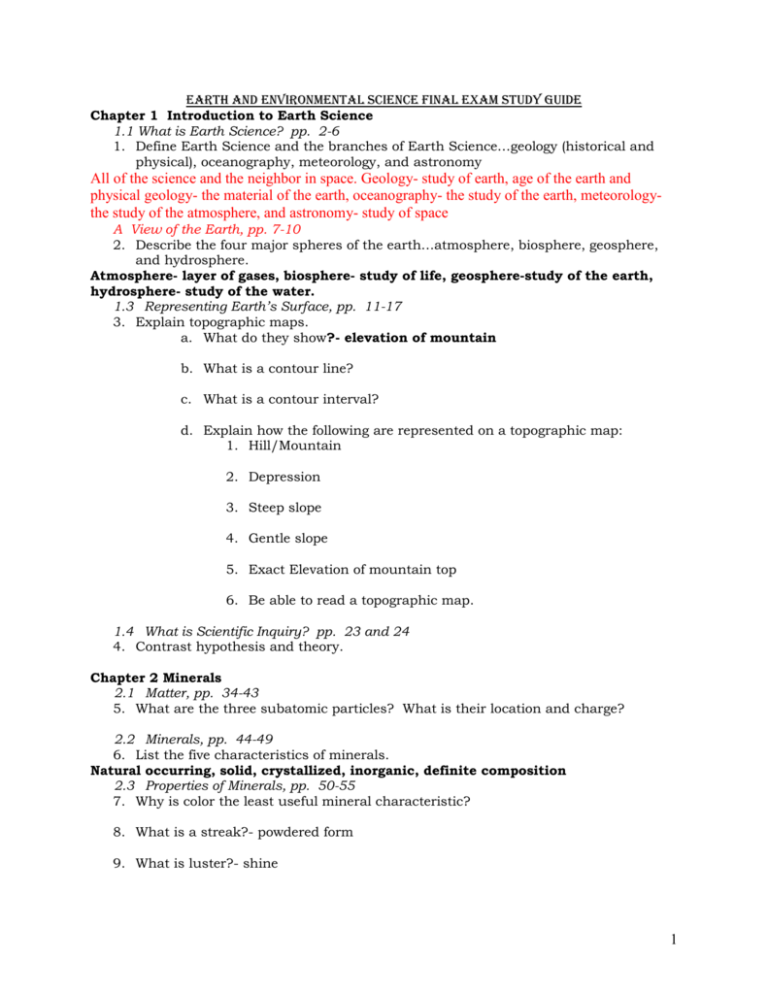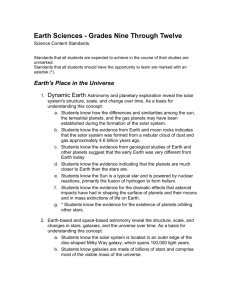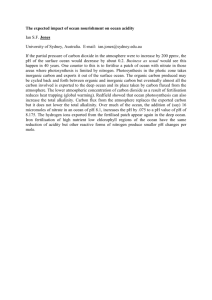Earth and Environmental Science Final Exam Study Guide Chapter
advertisement

Earth and Environmental Science Final Exam Study Guide Chapter 1 Introduction to Earth Science 1.1 What is Earth Science? pp. 2-6 1. Define Earth Science and the branches of Earth Science…geology (historical and physical), oceanography, meteorology, and astronomy All of the science and the neighbor in space. Geology- study of earth, age of the earth and physical geology- the material of the earth, oceanography- the study of the earth, meteorologythe study of the atmosphere, and astronomy- study of space A View of the Earth, pp. 7-10 2. Describe the four major spheres of the earth…atmosphere, biosphere, geosphere, and hydrosphere. Atmosphere- layer of gases, biosphere- study of life, geosphere-study of the earth, hydrosphere- study of the water. 1.3 Representing Earth’s Surface, pp. 11-17 3. Explain topographic maps. a. What do they show?- elevation of mountain b. What is a contour line? c. What is a contour interval? d. Explain how the following are represented on a topographic map: 1. Hill/Mountain 2. Depression 3. Steep slope 4. Gentle slope 5. Exact Elevation of mountain top 6. Be able to read a topographic map. 1.4 What is Scientific Inquiry? pp. 23 and 24 4. Contrast hypothesis and theory. Chapter 2 Minerals 2.1 Matter, pp. 34-43 5. What are the three subatomic particles? What is their location and charge? 2.2 Minerals, pp. 44-49 6. List the five characteristics of minerals. Natural occurring, solid, crystallized, inorganic, definite composition 2.3 Properties of Minerals, pp. 50-55 7. Why is color the least useful mineral characteristic? 8. What is a streak?- powdered form 9. What is luster?- shine 1 10. What is hardness? Be sure to know the scale number of talc and diamond. Be sure to understand how to read Moh’s hardness scale.OMIT 11. What is the difference between cleavage and fracture?- cleavage-even break, fracture-uneven break Chapter 3 Rocks 3.1. The Rock Cycle, pp. 66-69 12. What is a rock? List all three types and how they are formed. 13. 14. Know the rock cycle and all its parts and processes. Be sure to study Figure 2, p. 67. Distinguish between lava and magma. OMIT 3.2 Igneous Rocks, pp. 70-74 15. Where do intrusive igneous rocks form? List an example.OMIT 16. Where do extrusive igneous rocks form? List an example.OMIT 17. How does the rate of cooling affect an igneous rock’s texture? List an example of fine and coarse grain igneous rock. OMIT Chapter 4 Earth’s Resources 4.1 Energy and Mineral Resources, pp. 94-101 18. What is a renewable resource? List several examples. Substances that can be replenish in a short time 19. What is a nonrenewable resource? List several examples. Substances that can be replenish over a long period of time 4.2 Alternative Energy Sources, pp. 102-107 20. What are six alternative energy resources? List the source of energy for each resource. Solar nuclear, tidal, geothermal, hydroelectric, wind 4.4. Protecting Resource, pp. 113-116 21. Identify the protection provided by these laws: a. Clean Air Act- omit b. Clean Water Act-OMIT c. Resource Conservation and Recovery Act-OMIT Chapter 5 Weathering, Soil, and Mass Movements 5.1 Weathering, pp. 126-132 22. What is mechanical weathering? List examples. Physical breakdown of rocks ex. Frost wedging, unloading, biological activities 23. What is chemical weathering? List examples. Physical breakdown and new substance 5.2 Soil, pp. 133-142 24. What are the major components of soil? Humus, water, air, parent material 25. What factors affect the formation of soil? OMIT 2 26. What is the order of soil horizons from top to bottom in a mature soil profile? A, B, C, PARENT MATERIAL 27. What is the composition of soil horizon A? Horizon B? Horizon C? What are the names of these horizons? 5.3 Mass Movements, pp. 143-149 28. What is a mass movement? What is the force behind these movements? OMIT 29. Describe the different types of mass movements and their relative speeds. OMIT Chapter 6 Running Water 6.1 Running Water, pp. 158-163 30. Identify and describe all of the processes involved in the water cycle. Figure 2, p. 159 Chapter 9 Plate Tectonics 9.1 Continental Drift, pp. 248-253 31. Who developed the hypothesis of continental drift? What does say? Alfred Wegner the hypothesis 32. What are the four major pieces of evidence to support continental drift? 33. What is Pangaea? How did it breakup? 9.2 Plate Tectonics, pp. 254-255 34. Describe the three major plate boundaries. 9.3 35. 9.4 36. Actions at Plate Boundaries, pp. 258-264 Identify the features formed at the three major plate boundaries. Testing Plate Tectonics, pp. 265-268 How are the Hawaiian Islands formed? Chapter 8 Earthquakes and Earth’s Interior 8.1 What is An Earthquake? pp. 218-221 37. What is an earthquake? 38. Distinguish between the focus and epicenter of an earthquake. 39.What is a fault? 8.2 Measuring Earthquakes, pp. 222-228 40. What is the speed and motion of a P-wave? S-wave? Surface waves? 41. How is a surface wave produced? 42. To determine the epicenter of an earthquake, you use the difference in __________ of __________ and ___________ waves. 43. How many seismic locations do you need to determine the epicenter? 44. Which scale measures the amount of energy released by an earthquake? Amount of damage? 3 8.3 Earth’s Layered Structure, pp. 233-237 45. What is the composition of the crust? Outer core? Inner core? And the mantle? 46. What is the lithosphere? Asthenosphere? 47. What is the Moho and what does it do to earthquake waves? Chapter 10 Volcanoes and Other Igneous Activity OMIT ALL OF CHAPTER 10 10.1 The Nature of Volcanic Eruptions, pp. 280-288 48. What is volcanic ash and dust? Lapilli? Volcanic bombs and blocks? 49. Describe the three types of volcanoes…include drawings. 10.2 Intrusive Igneous Activity, pp. 289-292 50. A _____________ forms when magma is injected along horizontal sedimentary beds. 51. A _____________ is a lens-shaped intrusion. 52. Plutons that cut across sedimentary beds are called ___________. 53. The largest intrusion is called a ____________. Chapter 12, Geologic Time 12-1, Discovering Earth’s History, pp. 336-342 54. Why are sedimentary rocks important in studying geologic time? 55. Define uniformitarianism. 56. Describe the different stratigraphic principles: a. Law of Superposition: b. Principle of Original Horizontality: c. Principle of Cross-cutting Relationships: d. Inclusions: 57. Contrast angular unconformity, disconformity, and nonconformity. 58. What is the difference between relative dating and absolute dating? 59. Observe the cross-cutting diagram on p. 361. List the sequence from oldest to youngest. 12-2, Fossils: Evidence of Past Life pp. 343-346 60. What are fossils? What determines if an organism will become a fossil? 12-3, Dating with Radioactivity, pp. 347-350 61. What is the relationship between radioactivity and half-life? 62. Create and solve half life problems using X as the element (isotope). 4 63. What is needed to do radiometric dating? 64. In the scientific community, what is the accepted age of the earth? 12-4, The Geologic Time Scale, pp. 352-355 65. How is the geologic time scale structured? 66. Which expanse of time of the geologic time scale is the largest? Chapter 13, Earth’s History 13-1, Precambrian Time: Vast and Puzzling, pp. 364-368 67. List the divisions of geologic time from shortest to longest. 68. Which era covers about 88 % of Earth’s history? 69. Identify the eras from oldest to youngest. 13-2, Paleozoic Era: Life Explodes, pp. 369-376 70. Which continents made up Gondwanaland? Laurasia? 13-3, Mesozoic Era: Age of Reptiles, pp. 377-381 71. During which era did Pangaea begin to break up? 72. What animals dominated the Mesozoic Era? Chapter 14, The Ocean Floor 14-1, The Vast World Ocean, pp. 394-400 73. How much of the Earth’s surface is covered by ocean water? 74. Describe each of the four ocean basins according to size and depth. 14-2, Ocean Floor Features, pp. 401-405 75. Describe continental margin, continental shelf, continental slope, continental rise, and submarine canyons. 76. Describe ocean basin floor, deep-ocean trenches, abyssal plains, seamounts, guyots, mid-ocean ridges, and hydrothermal vents. Chapter 15, Ocean Water and Ocean Life 15-1, The Composition of Seawater, pp. 422-427 77. What is salinity? 78. Identify the most common salt in seawater. 79. How does temperature affect the density of seawater? Which layer of the ocean experiences a rapid change in density with depth? 80. What are the three main zones of the open ocean and their physical characteristics? 5 15-2, The Diversity of Ocean Life, pp. 428-432 81. What do you call: a. organisms that drift with ocean currents? List examples. b. organisms that move under their own power? List examples. c. organisms that live on the ocean bottom? List examples. 82. Open ocean at any depth is called the ______ zone? 15-3, Oceanic Productivity, pp. 433-437 83. What advantage do organisms in a food web have over those in a food chain? Chapter 16, The Dynamic Ocean 16-1, Ocean Circulation, pp. 448-453 84. What is the deflection of ocean currents as a result of earth’s rotation called? 85. What direction is water deflected in the northern hemisphere? In the Southern Hemisphere? 86. Why is upwelling important? 16-2, Waves and Tides, pp. 455-460 87. From where do ocean waves obtain their energy? 88. Describe the characteristics of waves: A. Wave height:: B. Wave length: C. Wave period: 89. What three factors affect the characteristics of a wave? 90. What force produces tides? 91.Contrast neap and spring tides…what kind of moon phase? Chapter 17, The Atmosphere: Structure and Temperature CH 17-1, Atmospheric Characteristics, pp. 476-482 92. How does weather differ from climate? 93. List the four major components of the atmosphere and their percentages. Also, list three variable components of the atmosphere. 94. What gas is the primary component of clouds and precipitation? 95. Describe ozone…its chemical structure, significance, and location. 96.What is the source of nearly half of all primary pollutants? 6 97. Identify and describe the four layers of the atmosphere. 98. What causes the seasons? 99. Trace earth’s orbit around the sun using summer solstice, autumnal equinox, winter solstice, and vernal equinox…use tilt of axis, length of daylight/night, weak/strong rays of solar radiation. CH. 17-2, Heating in the Atmosphere, pp. 483-487 100. Describe the three major mechanisms for heat transfer. CH. 17-3, Temperature Controls, pp. 488-493 101. How does the heating of land and water differ? 102. What happens to the temperature and pressure as you increase your altitude? 103. Define isotherm. Isotherms generally trend _______________ and _______________ and show a _______________ in temperatures from the ______________ toward the ________________. Chapter 18, Moisture in the Atmosphere CH. 18-1, Water in the Atmosphere, pp. 504-509 104. What is required during the process of changing state? 105. Describe the different phase changes or changes of state: a. Evaporation: b. Condensation: c. Sublimation: d. Deposition: 106. What is relative humidity? How does temperature affect relative humidity? 107. Explain dew point…what is the relationship between high and low temperatures and moist and dry air? CH. 18-2, Cloud Formation, pp. 510-516 108. What happens to air when it is compressed or allowed to expand? 109. What are three sources of cloud condensation nuclei? CH. 18-3, Cloud Types and Precipitation, pp. 517-522 110. How are clouds classified? 111. Describe the three types of clouds. 112. Define the following prefixes and suffixes. Cirro, alto, strato, and nimbus/nimbo. Chapter 19, Air Pressure and Wind CH. 19-1, Understanding Air Pressure, pp. 532-536 113. What is the ultimate energy source for wind? 7 114. What three factors combine to control wind? 115. Define isobars. How are isobars related to pressure gradient and wind speed? CH. 19-2, Pressure Centers and Winds, pp. 537-542 116. Describe how winds blow around pressure centers in the Northern and Southern Hemispheres. 117. What are the air pressure patterns within cyclones and anticyclones? 118. What kind of weather is associated with a low-pressure system? A high-pressure system? CH. 19-3, Regional Wind Systems, pp. 543-548 119. Contrast land breezes and sea breezes. 120. What instrument is used to measure: air pressure, temperature, humidity, wind speed, and wind direction? 121. Describe El Nino….what is it? Frequency? Affect on weather in the southeastern US? 122. Describe La Nina…what is it? Frequency? Affect on weather in the US? Chapter 20 Weather Patterns and Severe Storms CH. 20-1, Air Masses, pp. 558-563 123. What is an air mass and how are they classified? 124. Describe the four basic types of air masses. CH. 20-2, Fronts, pp. 564-570 125. Describe the four types of fronts…include a description of what is happening, map representation, and types of precipitation expected. CH. 20-3, Severe Storms, pp. 571-577 126. Compare and contrast different types of severe weather…include description, formation, safety, and rating scales. a. Thunderstorms: b. Tornadoes: c. Hurricanes: Chapter 21 Climate CH. 21-1, Factors That Affect Climate, pp. 588-591 127. Create a table that summarizes the effects of each factor on climate: a. Latitude: b. Elevation: c. Topography: d. Water bodies: 8 e. Global wind: f. Vegetation: CH. 21-2, World Climates, pp. 592-599 128. Compare and contrast tropical, temperate (or middle-latitude), and polar climate zones. CH. 21-3, Climate Changes, pp. 600-603 129. What is the greenhouse effect? 130.What are some of the consequences of global warming? Chapter 22 Origin of Modern Astronomy CH. 22-1 Early Astronomy, pp. 614-621 131. How does the geocentric model of the solar system differ from the heliocentric model? 132. For each of the following scientists, describe their contributions to astronomy: a. Aristotle b.Copernicus c.Newton d.Galileo CH. 22-2 The Earth-Moon-Sun System, pp. 622-629 133. Compare and contrast perihelion (perigee) and aphelion (apogee). 134. Trace the complete lunar cycle with phases of the moon and a drawing of each phase. 135. Describe the location of the sun, moon, and Earth during a solar eclipse and during a lunar eclipse. Chapter 23 Touring Our Solar System CH. 23-1 The Solar System, pp. 644-648 136. How do terrestrial planets differ from Jovian planets? Identify which planets are terrestrial and which planets are Jovian. 137. How did the solar system form? 138. How did distance from the sun affect the size and composition of the planets? CH. 23-2 The Terrestrial Planets, pp. 649-653 139.Write a brief summary of the characteristics of each terrestrial planet. CH. 23-3 The Outer Planets, pp. 654-659 9 140.Write a brief summary of the characteristics of each outer planet. Chapter 24 Studying the Sun CH. 24-1 The Study of Light, pp. 674-677 141.How can scientists determine whether a star is moving toward or away from Earth? CH. 24-3 The Sun, pp. 684-690 142.Describe the structure of the sun…Figure 12, p. 685 A. Interior…core, radiation zone, and convection zone. B. Photosphere C. Chromosphere D. Corona 143.Describe the types of solar activity: A. Sunspots/Sunspot cycle B. Prominences C. Solar Flares 144.How does the sun produce energy? Chapter 25 Beyond Our Solar System CH. 25-1 Properties of Stars, pp. 700-706 145.What can astronomers learn by studying a star’s color? CH. 25-2 Stellar Evolution, pp. 707-714 146. Describe the life cycle of stars: A. Protostar Stage: B. Main-Sequence Stage: C. Red-Giant Stage: D. Burnout and Death: 1. Death of Low-mass stars 2. Death of Medium-mass stars 3. Death of Massive stars CH. 25-3 The Universe, pp. 715-721 147. What is the size and shape of the Milky Way Galaxy? 148. What evidence indicates that the universe is expanding? 149. What is the Big Bang Theory? 10








